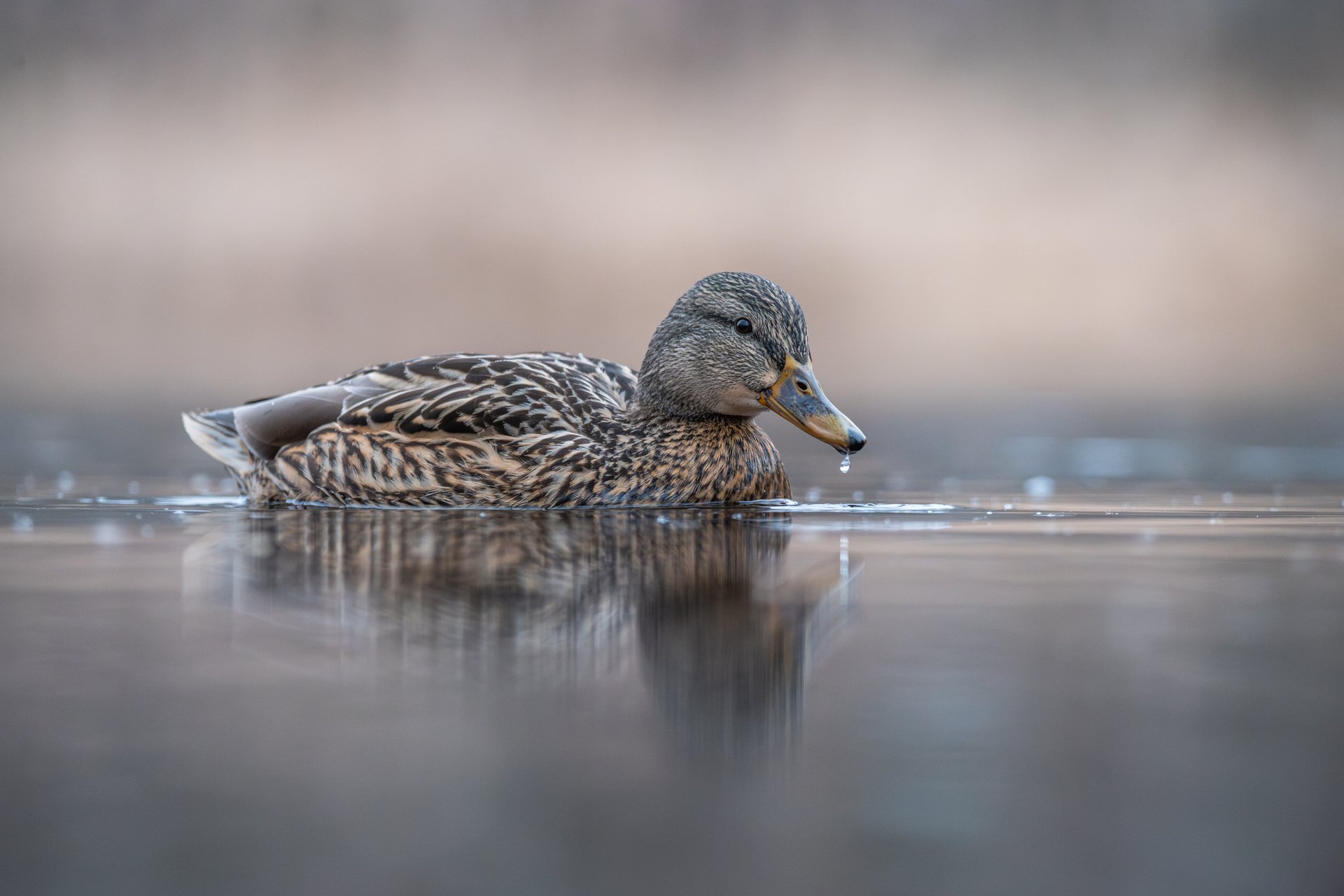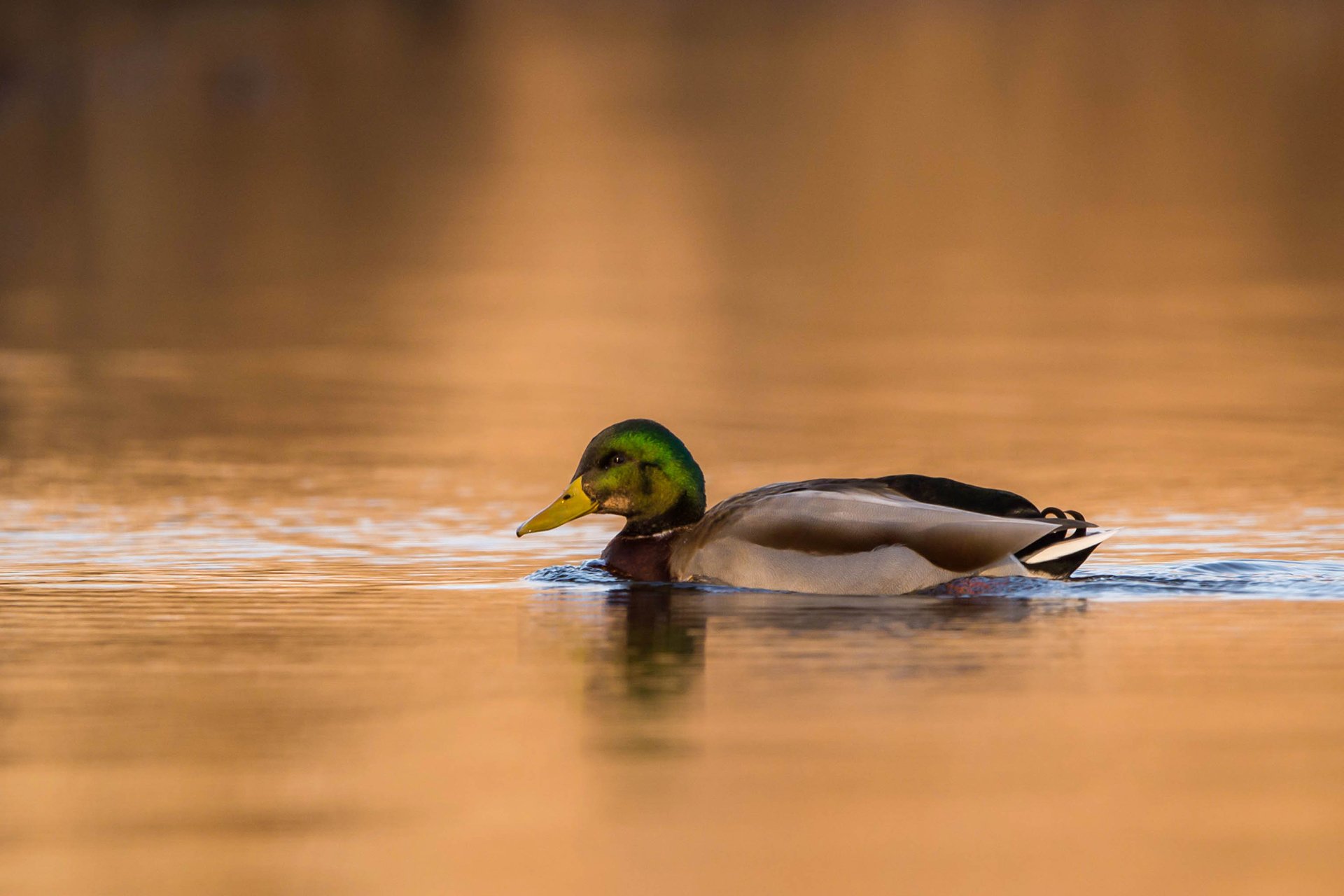Birds in Massachusetts
Mallards
Ducks are familiar residents of many urban and suburban parks across the Commonwealth. There are 16 duck species that breed in Massachusetts, and dozens of others can be spotted outside of the breeding season.
Of the 16 breeding species, the mallard is the most commonly seen or encountered.
How to Identify Mallards
Male vs Female Mallards
Male mallards, known as drakes, exhibit a striking combination of colors. They have a glossy green head, a bright yellow bill with a black tip, and a white collar that contrasts sharply with their chestnut-brown chest. Their body is mainly gray, with black on the rear and a distinctive blue patch on the wing.
Female mallards, or hens, are more subtly colored, with mottled brown plumage, a darker crown, and an orange bill with dark markings.
Both genders have a distinctive iridescent blue speculum bordered by white on their wings.
Mallard Behavior
Mallard Life Cycle
Mallards can be seen in parks and ponds in large numbers in fall and winter but will break off into pairs when breeding season comes. While some mallards will choose a nest site near the water, it is not uncommon for them to nest as far as a mile from the nearest water. The nest is usually on the ground hidden by vegetation, but occasionally they will select a site on a stump or even in a basket.
The nest is a shallow bowl of vegetation lined with down. The hen lays one egg per day and will only incubate sporadically until the clutch is complete, typically from 7-10 eggs. The drake often leaves the pair at this point.
Ducklings hatch after 28 days and are born precocial, meaning that they are able to walk, swim, and feed themselves almost immediately after hatching. The hen then leads the young to the water, leaving the nest for good. Ducklings stay with the hen until they can fly at roughly two months old.
In late summer, after the brood has become independent, the adults will molt, making them flightless for a period of time. Massachusetts Mallards are likely short-distance migrants—if they migrate at all.
What Do Mallard Ducks Eat?
A mallard's primary diet consists of vegetable matter such as grains, acorns, and aquatic vegetation. But in the breeding season, their diet shifts to encompass more animal matter such as insects, snails, minnows, and shrimp.
Why You Shouldn’t Feed the Ducks
Giving food to ducks and geese can create many problems for birds and the environment. Both Mass Audubon and the Massachusetts Division of Fisheries and Wildlife (MDFW) discourage it. Find out why feeding ducks and geese is not recommended
Mallard Duck Call
How to Deter Mallards
How to Deter Ducks from Visiting Swimming Pools
During the winter, rain and snow may accumulate on the covers of swimming pools, along with leaf litter and debris. This creates a temporary habitat for aquatic invertebrates come springtime.
Owners of swimming pools often discover that a pair of ducks—almost always mallards—has taken over this newly created pond and are eating the invertebrates.
Ducks on a pool cover present no problem; they are simply there because there is food, or possibly because a female mallard is nesting under a nearby shrub. It is illegal to disturb a nest or eggs, but you can prevent ducks from using the pool cover as follows:
- Remove the cover. If this is not possible, clear the cover of water and debris, and keep emptying the water after it rains
- Ducks can sometimes be driven off by harassment, by clapping loudly or banging pots and pans together. This disturbance has to be repeated frequently before the ducks will give up and leave for good. If it is determined that there is a nest in the vicinity, do not harass the birds as this will likely cause the female to abandon her eggs.
If ducks are using the pool itself there is no health risk, as pool chemicals will neutralize duck waste. To encourage the ducks to leave:
- Purchase Mylar streamers, which are available in the crepe paper section at most party stores. Place three-foot high stakes in the ground at each corner of the pool, then stretch the Mylar from stake to stake across the pool to form an “X.” The flashing, uneven movement of the streamers normally frightens the birds away.
- Place a lightweight cover, such as a solar cover, over the pool when it is not being used.
- Try the harassment techniques described above.
- Do not waste money on plastic owls or snakes; birds quickly learn that the predator is a fake.
How to Deter Ducks from Nesting in Enclosed in Areas
Female mallards often nest in enclosed spaces such as the courtyard of a building or a fenced yard (most often with a swimming pool). Though the mother duck is able to fly in and out of the area, the newly hatched young cannot escape. Although they can walk immediately after hatching, they are unable to fly for approximately the first 60 days.
Once the ducklings hatch, gather several people together and slowly and quietly herd them toward an exit. If the only route is through a building, place the ducklings in a shallow box and slowly carry it outside. The female may follow if she can hear her offspring. Place the box on the ground—if the mother’s nearby, tip the box so the young can run out and join her.
If she is not present, place the box on the ground and wait out of sight for her return. If you noticed that the female always flew out of the enclosure in the same direction while she was tending to the nest, put the box on that side of the building.
How Mass Audubon is Supporting Birds in Massachusetts
Mass Audubon works at our wildlife sanctuaries and beyond to ensure that the nature of Massachusetts continues to thrive. By scientifically monitoring Massachusetts birdlife, Mass Audubon informs important conservation decisions and launches targeted initiatives to help at-risk species. In addition, fostering healthy habitats, supporting native species, and educating people about the importance of nature conservation is critical to our success. Learn more about our work
How You Can Support Birds in Massachusetts
Mass Audubon supports birds like Mallards every day, but we couldn’t do it without the support of our 160,000+ members.
Help support Mallards, and birds like them, by becoming a member today.
Upcoming Bird Programs
Wednesday Morning Bird Walk
-
Blue Hills Trailside Museum, Milton
-
Wednesday, January 14
9:00-10:00am
Adults
Wednesday Morning Birding
-
Newburyport and vicinity
-
Wednesday, January 14
9:30am-12:30pm
Adults
Wednesday Morning Birding
-
Arcadia Wildlife Sanctuary, Easthampton
-
Wednesday, January 14
10:00-11:30am
Adults
Stay Connected
Don't miss a beat on all the ways you can get outdoors, celebrate nature, and get involved.






